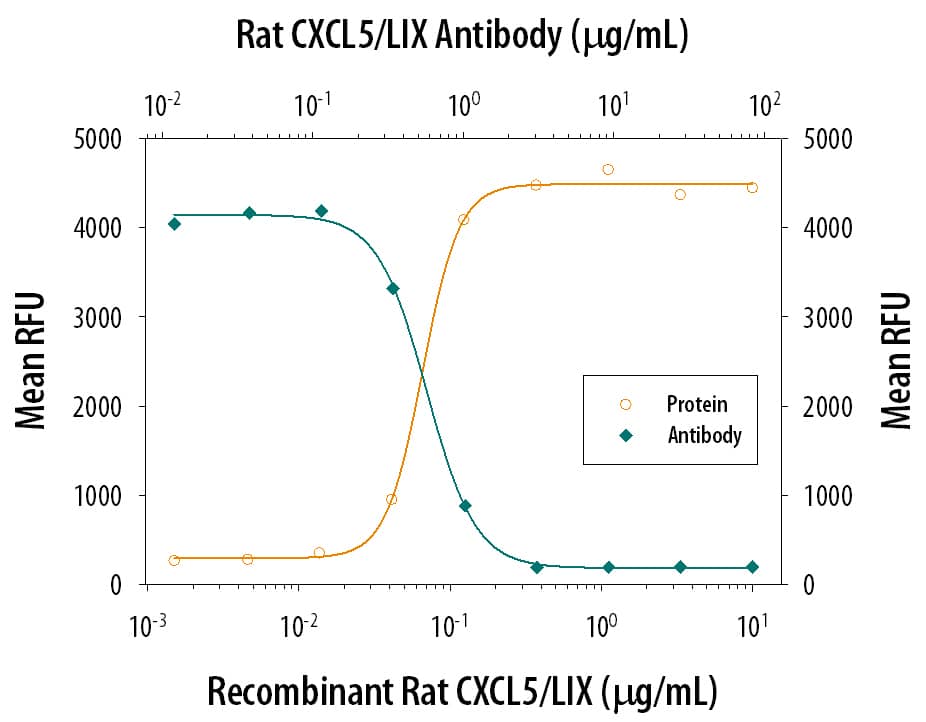Rat LIX Antibody
R&D Systems, part of Bio-Techne | Catalog # AF543


Key Product Details
Species Reactivity
Validated:
Cited:
Applications
Validated:
Cited:
Label
Antibody Source
Product Specifications
Immunogen
Ala38-Gln130
Accession # P97885.1
Specificity
Clonality
Host
Isotype
Endotoxin Level
Scientific Data Images for Rat LIX Antibody
Chemotaxis Induced by LIX and Neutralization by Rat LIX Antibody.
Recombinant Rat LIX (Catalog # 543-RL) chemo-attracts the BaF3 mouse pro-B cell line transfected with human CXCR2 in a dose-dependent manner (orange line). The amount of cells that migrated through to the lower chemotaxis chamber was measured by Resazurin (Catalog # AR002). Chemotaxis elicited by Recombinant Rat LIX (0.2 µg/mL) is neutralized (green line) by increasing concentrations of Goat Anti-Rat LIX Antigen Affinity-purified Polyclonal Antibody (Catalog # AF543). The ND50 is typically 0.3-1.5 µg/mL.Applications for Rat LIX Antibody
Western Blot
Sample: Recombinant Rat LIX (Catalog # 543-RL)
Neutralization
Formulation, Preparation, and Storage
Purification
Reconstitution
Formulation
Shipping
Stability & Storage
- 12 months from date of receipt, -20 to -70 °C as supplied.
- 1 month, 2 to 8 °C under sterile conditions after reconstitution.
- 6 months, -20 to -70 °C under sterile conditions after reconstitution.
Background: LIX
LPS-induced CXC chemokine (LIX) is a chemokine originally cloned from LPS-stimulated mouse fibroblasts. Rat LIX shares approximately 74% amino acid (aa) sequence identity with mouse LIX and is likely the rat orthologue to mouse LIX. Rat LIX cDNA encodes a 130 aa residue precursor with a predicted 37 aa residue signal peptide and a 93 aa residue mature protein. Among human CXC chemokines, rat LIX is most closely related to human GCP-2 and ENA-78. Rat LIX also differs from these two human proteins by having an extended carboxy-terminus. The amino-terminal 115 residues of rat LIX shares 59% and 53% aa sequence homology with human GCP-2 and ENA-78, respectively. It is not clear if LIX should be considered an orthologue of GCP-2 or ENA-78. Yet, mouse LIX was alternatively named mouse GCP-2.
Purified recombinant rat LIX is C-terminally truncated. This is consistent with the observation that natural mouse LIX purified from fibroblasts and epithelial cells also contains multiple amino-terminal and carboxy-terminal truncated isoforms. The shorter isoforms of the natural protein were reported to be more active than the longer forms. The bioactivity of rat LIX can be mediated through CXCR2.
References
- Proost, P. et al. (1993) J. Immunol. 150:1000.
- Smith, J.B. and H.R. Herschman (1995) J. Biol. Chem. 270:16756.
- Rovai, L.E. et al. (1997) J. Immunol. 158:5257.
- Wuyts, A. et al. (1997) J. Immunol. 157:1736.
Alternate Names
Gene Symbol
UniProt
Additional LIX Products
Product Documents for Rat LIX Antibody
Product Specific Notices for Rat LIX Antibody
For research use only